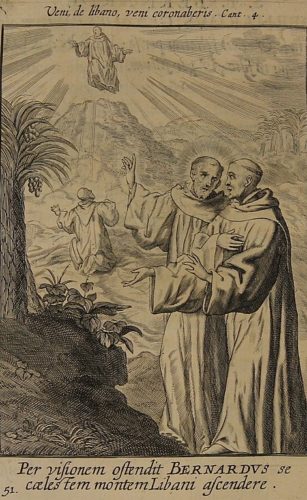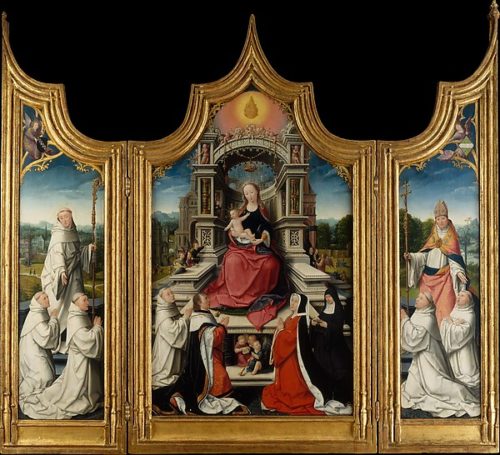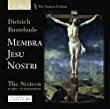Last Updated on January 16, 2025 by Kittredge Cherry

Bernard of Clairvaux was a medieval French abbot who wrote homoerotic poetry about Jesus and had a passionate same-sex friendship with Irish archbishop Malachy of Armagh. Bernard is best known for founding 70 monasteries around Europe and for his mystical writings. His feast day is Aug. 20.
His long love poem to Jesus includes these lines:
“With my mouth I touch and worship Thee,
With all the strength I have I cling to Thee,
With all my love I plunge my heart in Thee,
My very life-blood would I draw from Thee,
Jesus, Jesus I draw me into Thee.”
Bernard’s first love was Jesus, but he showered Malachy with kisses during his lifetime. After Malachy died in his arms, they exchanged clothes. Malachy was buried in Bernard’s habit. Bernard put on Malachy’s habit to lead the funeral and wore it until his own death five years later. Bernard was buried beside Malachy, again in Malachy’s habit. Malachy (1094-1148) became the first native born Irish saint to be canonized.

Malachy of Armagh, left, and Bernard of Clairvaux by Rowan Lewgalon
Bernard and his legendary white dog, both with icy blue eyes, appear together in a striking contemporary portrait by Rowan Lewgalon. She is a spiritual artist based in Germany and a cleric in the Old Catholic Apostolic Church.
“Jesus to me is honey in the mouth”
Bernard (1090-1153) was advisor to five Popes and a monastic reformer who built the Cistercian order of monks and nuns. He is known as the last of the Church Fathers. The most famous saying attributed to him is: “The road to hell is paved with good intentions.”
He was a man of his time who engaged in rigorous ascetic practices and supported church teachings on celibacy. People today might say that he had a homosexual orientation while abstaining from sexual contact. Medieval mystics created alternative forms of sexuality that defy contemporary categories, but might be encompassed by the term “queer.” They directed their sexuality toward God and experienced God’s love through passionate friendship with another human being.
Monasteries and convents provided a social structure outside marriage, attracting many people that today would be defined as LGBTQ. Medieval monks and nuns who lived in same-sex communities under a vow of celibacy developed alternative ways of same-sex living and loving.
A prayer written by Bernard’s secretary Geoffrey shows how the community at Clairvaux understood and celebrated the man-to-man love between Bernard and Malachy. He thanks God for these “two stars of such surpassing brightness” and “twofold treasure.”
Bernard’s strict asceticism was balanced by sweetly erotic visions that earned him the title Doctor Mellifluus (“honey-tongued doctor.”) He chose to use the Song of Songs, the most erotic book in the Bible, as a major vehicle for his teaching. He began his “Sermons on the Song of Songs” in 1135 and had completed 86 sermons when he died nearly 20 years later with the series still unfinished.
“Jesus to me is honey in the mouth, music in the ear, a song in the heart,” he wrote in his 15th sermon on the Song of Songs.
 His lesser known works include “Life of Saint Malachy of Armagh,” which is his idealized tribute to the man he loved, and “Salve Mundi Salutare” (quoted below), a love poem to Jesus whose original homoeroticism has been suppressed. It became the basis for the popular English hymn “O Sacred Head, Now Wounded.”
His lesser known works include “Life of Saint Malachy of Armagh,” which is his idealized tribute to the man he loved, and “Salve Mundi Salutare” (quoted below), a love poem to Jesus whose original homoeroticism has been suppressed. It became the basis for the popular English hymn “O Sacred Head, Now Wounded.”
Bernard of Clairvaux’s legacy is a mixed blessing because he also helped rally soldiers to kill Muslims in the Second Crusade and undermined the work of theologian Peter Abelard, a champion of reason. But he spoke out against Christian mistreatment of Jews and supported another queer mystic, Hildegard of Bingen, in her efforts to get her visions published.
Bernard of Clairvaux connects with men in art
Artists portray Bernard’s close, maybe even homoerotic relationships with male figures. The rapture of his love for Jesus is expressed in the painting “Christ Embracing St. Bernard” by Francisco Ribalta. The Spanish Baroque artist apparently painted this masterpiece for the Carthusian monastery of Porta Coeli in Valencia, Spain around 1625.
The website for Spain’s Prado Museum in Madrid, where it is now housed, states: “The scene is based on one of the saint’s mystical visions, drawn from one of the most popular religious books of the Baroque era: Pedro de Ribadeneyra’s ‘Flos Sanctorum’ or ‘Book of the Lives of the Saints,’ published in 1599.”

“Bernard has a mystical vision about ascending Mount Lebanon” by Jacobus Neeffs, 1653 (Wikimedia Commons)
Bernard has a mystical vision of joyfully ascending Mount Lebanon with a male companion in a 1653 engraving by Flemish artist Jacobus Neeffs. The Latin text translates as, “Come out of Lebanon, come to be crowned.” It is a shortened version of Song of Songs 4:8, which says, “Come out of Lebanon, my bride, come to be crowned.”
Early life of Bernard of Clairvaux
Bernard was born to a noble family in 1090 on the outskirts of Dijon in Burgundy. According to legend, his mother had a dream during her pregnancy that a white puppy was barking in her womb. This was interpreted to mean that she would give birth to God’s watchdog. The white dog became one of Bernard’s attributes, a symbol used in images of the saint.
When Bernard was 19, his mother died and he decided to join a small new community that had just started in the area. They were called the Cistercians, and their aim was to reform monasticism with a return to the more austere rules of St. Benedict. Within three years Bernard was sent to found a monastery nearby in a place whose name has become part of his own: Clairvaux.
He mentored Aelred of Rievaulx, the patron saint of friendship and also, some say, gay. Aelred travelled from England to France every year to visit Clairvaux, where Bernard was abbot. He wrote his book “The Mirror of Charity” when Bernard asked him to write a book about love and suggested the title.
Bernard and Malachy became passionate friends
About 25 years later Bernard met Malachy (whose Irish name is Maelmhaedhoc O’Morgair). He was primate of all Ireland when he first visited Clairvaux around 1139.
Bernard was nearly 50 years old and Malachy was four years younger. They soon became devoted, passionate friends. Malachy even asked the Pope for permission to become a Cistercian, but the Pope refused.
 Malachy traveled to see Bernard again in 1142. They were so close that Bernard covered him with kisses in a scene that is described well by Orthodox priest Richard Cleaver in “Know My Name: A Gay Liberation Theology”: “Bernard’s account makes deeply romantic reading for a modern gay man. “Oscula rui,” Bernard says of their reunion: “I showered him with kisses.”
Malachy traveled to see Bernard again in 1142. They were so close that Bernard covered him with kisses in a scene that is described well by Orthodox priest Richard Cleaver in “Know My Name: A Gay Liberation Theology”: “Bernard’s account makes deeply romantic reading for a modern gay man. “Oscula rui,” Bernard says of their reunion: “I showered him with kisses.”
Their relationship had lasted almost a decade when Malachy reunited with Bernard for the third and final time. Malachy fell sick when he arrived in Clairvaux in 1148. He died in Bernard’s arms on All Soul’s Day, Nov. 2. Again Cleaver tells the details based on accounts by Geoffrey, Bernard’s secretary and traveling companion:
“Geoffrey of Auxerre tells us what happened later. Bernard put on the habit taken from Malachy’s body as it was being prepared for burial at Clairvaux, and we wore it to celebrate the funeral mass. He chose to sing not a requiem mass but the mass of a confessor bishop: a personal canonization and, incidentally, an example of using liturgy to do theology. Bernard himself was later buried next to Malachy, in Malachy’s habit. For Bernard, as for us today, this kind of passionate love for another human being was an indispensable channel for experiencing the God of love.”
After Malachy’s death Bernard lived on for another five years. He died on Aug. 20, 1153 at age 63. He was buried at the Clairvaux Abbey next to Malachy, wearing Malachy’s habit. He had lived for 40 years in community with other men whose loving relations with each other brought them closer to God.
An intriguing postscript is offered in the book “Queerly Lutheran” by Megan Rohrer: “After Bernard’s death, many French individuals believed that if they passed under the rainbow of Saint Bernard, they would undergo a gender metamorphosis.”
Legacy of Bernard of Clairvaux
 Bernard forbid sculptures and paintings at the monastery during his lifetime, but by the late 15th century the altarpiece at the Clairvaux Abbey had a painting of Christ’s baptism jointly witnessed by Bernard and Malachy. And now saint medals with Bernard’s face are common.
Bernard forbid sculptures and paintings at the monastery during his lifetime, but by the late 15th century the altarpiece at the Clairvaux Abbey had a painting of Christ’s baptism jointly witnessed by Bernard and Malachy. And now saint medals with Bernard’s face are common.

Bernard and Malachy in the Le Cellier Altarpiece
Bernard and Malachy gather others around the throne of the Madonna and child in the Le Cellier Altarpiece from 1509 by Jean Bellegambe. Bernard stands on the left while Malachy stands on the right. It comes from a chapel in the Cistercian abbey of Clairvaux,
“Bernard of Clairvaux” was sketched as an intense man with a rusty beard by Tobias Haller, an iconographer, author, composer, and retired vicar of Saint James Episcopal Church in the Bronx, still assisting at a parish in Baltimore, Maryland. He is the author of “Reasonable and Holy: Engaging Same-Sexuality.” Haller enjoys expanding the diversity of icons available by creating icons of LGBTQ people and other progressive holy figures as well as traditional saints. He and his spouse were united in a church wedding more than 30 years ago and a civil ceremony after same-sex marriage became legal in New York.
Bernard of Clairvaux wrote a love poem to Jesus
As a monk, Bernard naturally directed much of his erotic energy toward Jesus Christ. This attitude is beautifully expressed in his poem “Salve Mundi Salutare” (Savior of the World, I Greet You). He wrote seven sections, each addressed to a different parts of Jesus’ crucified body: his feet, knees, hands, side, chest, face, and finally his heart.
Christian tradition tries to make this kind of poetry into heterosexual eroticism by considering the soul and the church to be female while God is male. Bernard’s poem fits into a tradition of queer “bridal mysticism” of a same-sex “mystical marriage” to Jesus include other men honored by the church, such as John of the Cross, John of La Verna, and Bernardo de Hoyos.
The poem is traditionally attributed to Bernard of Clairvaux, although some modern scholars believe it may have been written by another Cistercian abbot, Arnulf of Leuven. It is also known as the “Oratio rhythmica ad singula membra Christi a cruce pendentis” (Rhythmical Prayer to the Sacred Members of Jesus Hanging on the Cross), or more simply as the Rhythmica oratio.
The original poem, in all its erotic glory, is generally not included in books that collect Bernard’s “essential writings.” It lives on in ancient, hard-to-find editions and heavily edited versions and translations that remove much of the homoeroticism and sometimes even add heterosexual references that are absent from Bernard’s original Latin. The original is also blessedly free from churchy terms like “Lord,” speaking only of the love between “I” and “thou.”
 The poem is the basis for important musical works such as the hymn “O Sacred Head, Now Wounded” and the Baroque oratorio “Membra Jesu Nostri” (usually translated as “The Limbs of Our Jesus”) written by Baroque Danish composer Dieterich Buxtehude in 1680, more than 500 years after Bernard died. The cycle of seven cantatas is considered to be the first Lutheran oratorio. The entire oratorio can be heard on video at this link.
The poem is the basis for important musical works such as the hymn “O Sacred Head, Now Wounded” and the Baroque oratorio “Membra Jesu Nostri” (usually translated as “The Limbs of Our Jesus”) written by Baroque Danish composer Dieterich Buxtehude in 1680, more than 500 years after Bernard died. The cycle of seven cantatas is considered to be the first Lutheran oratorio. The entire oratorio can be heard on video at this link.
The whole poem contains 74 verses of five lines each — way too many to reproduce here. But it is extremely hard to find, so a selection of the more erotic, lesser known verses are reproduced here in the original Latin with an English translation from by Emily Mary Shapcote. Her translation was published in the 1881 book “St. Bonaventure’s Life of our Lord and Saviour Jesus Christ.” The online version of that book contains the entire poem in its appendix.
In a few cases a computer-generated English translation is also included here because it captures the directness and immediacy of the original. Much of the homoeroticism is implicit in the fact that this love poem was written by one man to another — from Bernard to Jesus with love.
References to this poem and numerous paintings of Bernard with Christ are included in a whole chapter devoted to Bernard in the 2013 book “Saintly Brides and Bridegrooms: The Mystic Marriage in Renaissance Art” by Carolyn D. Muir, art professor at the University of Hong Kong.
___
Prayer to the Sacred Members of Jesus
“Membra Jesu Nostri”
by Bernard of Clairvaux
To the Hands
Ad Manus
IX.
O Jesus, place Thy sacred Hands on me,
With transport let me kiss them tenderly,
With groans and tears embrace them fervently;
And, O for these deep wounds I worship Thee;
And for the blessed drops that fall on me.
Manus sanctse vos amplector,
Et gemendo condelector,
Grates ago plangis tantis
Clavis duris, guttis sanctis,
Dans lacrymas cum osoulis
To the Side
Ad Latus
VII.
Lord, with my mouth I touch and worship Thee,
With all the strength I have I cling to Thee,
With all my love I plunge my heart in Thee,
My very life-blood would I draw from Thee,
Jesus, Jesus I draw me into Thee.
Google translate version:
You happen to my mouth,
And I ardently embrace
SOAK you in my heart,
And a warm heart, tongue,
Me all over you.
Ore meo te contingo,
Et ardenter ad me stringo
In te meum cor intingo,
Et ferventi corde lingo,
Me totum in te traiice.
To the Breast
Ad Pectus
VIII.
Abyss of wisdom from eternity,
The harmonies of angels worship Thee;
Entrancing sweetness flows, Breast, from Thee
John tasted it as he lay rapt on Thee;
Grant me thus that I may dwell in Thee.
Tu abyssus es sophise,
Angelorum harmonise
Te collaudant, ex te fluxit
Quod Joannes Cubans suxit,
In te fac ut iuliabitem.
To the Heart
Ad Cor
VI.
O sinner as I am, I come to Thee;
My very vitals throb and call for Thee;
O Love, sweet love, draw hither unto me!
O Heart of Love, my heart would ravished be,
And sicken with the wound of love for Thee!
Per medullam cordis mei,
Peccatoris atque rei,
Tuus amor transferatur,
Quo cor totum rapiatur,
Languens amoris vuluere.
VII.
Dilate and open, Heart of love, for me,
And like a rose of wond’rous fragrance be,
Sweet Heart of love, united unto me;
Anoint and pierce my heart, O Love, with Thee,
How can he suffer, Lord, who loveth Thee?
Google Translate version:
Spread, open,
Wonderfully smelling like a rose,
Join you in my heart,
MARK and anoint it,
Who does what he loves you!
Dilatare, aperire,
Tanquam rosa fragrans mire,
Cordi meo te conjunge,
Unge illud et compunge,
Qui amat te quid patitur!
IX.
Mv living heart, O Love, cries out for Thee;
With all its strength, O Love, my soul loves Thee;
O Heart of Love, incline Thou unto me,
That I with burning love may turn to Thee,
And with devoted breast recline on Thee.
Viva cordis voce clamo,
Dulce cor, te namque amo;
Ad cor meum inclinare,
Ut se possit applicare,
Devoto tibi pectore.
XI.
Thou Rose of wondrous fragrance, open wide,
And bring my heart into Thy wounded Side,
O sweet Heart, open! Draw Thy loving bride,
All panting with desires intensified,
And satisfy her love unsatisfied.
Rosa cordis aperire,
Cujus odor fragrat mire,
Te dignare dilitare,
Fac cor meum anhelare,
Flam ma desiderii.
[Note that the original Latin has absolutely no references to brides or any gender at all. This is the only verse quoted here that is also included in Buxtehude’s oratorio “Membra Jesu Nostri”.]
XIII.
O Jesus, draw my heart within Thy Breast,
That it may be by Thee alone possessed.
O Love, in that sweet pain it would find rest,
In that entrancing sorrow would be blest,
And lose itself in joy upon Thy Breast.
Google Translate version:
Put in your pocket
Heart, that you should take a neighbor,
Joyful in pain,
With ugly and beautiful
That hardly contain himself.
Infer tuum intra sinum
Cor, ut tibi sit vicinum,
In dolore gaudioso,
Cum deformi specioso,
Quod vix seipsum capiat.
___
*Quotation at the top is Shapekote’s translation of:
Cordis mei Cor dilectum,
In te meum fer aflectum,
Hoc est quod opto plurimum.
Direct translation:
Heart of my heart, beloved,
You bring in my feelings,
This is what I love most.
Links related to Bernard of Clairvaux
Catholic Queer Families: SS Bernard of Clairvaux and Malachy (Queering the Church)
St. Bernard of Clairvaux’s Life of Saint Malachy of Armagh (full text)
“Rhythmical Prayer to the Sacred Members of Jesus Hanging Upon the Cross” by Bernard of Clairvaux. Full text in Latin and English. (scroll down to find is as an appendix of “St. Bonaventure’s Life of our Lord and Saviour Jesus Christ”)
Life of St. Malachy by Bernard of Clairvaux
Bernard of Clairvaux’s “homophilic poems” and love for archbishop Malachy are mentioned in “In the Closet of the Vatican: Power, Homosexuality, Hypocrisy” by Frederic Martel.
Prière au Christ Arc-en-Ciel: le drapeau LGBT révèle le Christ queer (Rainbow Christ Prayer in French)
Oratio ad Christum Iris Arcus (Rainbow Christ Prayer in Latin)
___
To read this post in Spanish / en español, go to Santos Queer:
San Bernardo de Claraval y San Malaquías: “el doctor meloso” y el arzobispo a quien amaba
It includes an original Latin-to-Spanish translation of the poem exclusively for Santos Queer by an important professor in Argentina: Dr. Luis Angel Sanchez, Professor of Latin Language and Culture at the University of Cordoba.
Or go to:
San Bernardo de Claraval y San Malaquías: “el doctor meloso” y el arzobispo a quien amaba (cristianosgays.com)
To read this post in Latvian, go to:
Viena dvēsele un viena miesa – Bernards no Klervo un visas Īrijas arhibīskaps Malahijs… (www.didziskukainis.lv)
___
Top image credit:
Detail from “Bernard has a mystical vision about ascending Mount Lebanon” by Jacobus Neeffs, 1653 (Wikimedia Commons)
____
This post is part of the LGBTQ Saints series by Kittredge Cherry. Traditional and alternative saints, people in the Bible, LGBTQ martyrs, authors, theologians, religious leaders, artists, deities and other figures of special interest to lesbian, gay, bisexual and transgender and queer (LGBTQ) people and our allies are covered.
This article was originally published on Q Spirit in August 2017, was expanded with new material over time, and was most recently updated on Jan. 16, 2025.
Copyright © Kittredge Cherry. All rights reserved.
Qspirit.net presents the Jesus in Love Blog on LGBTQ spirituality.























Surely you realize that kissing was (and still is in some societies such as in the Middle East) the standard form of greeting, like shaking hands in the U.S. Is every Middle-Eastern person gay because they kiss on the cheek when greeting everyone? Bernard of Clairvaux’s “love poem” just uses standard imagery for that era, and has nothing erotic in it. Using Google’s machine translation to try to make it more erotic is ridiculous, because machine translation is often extremely inaccurate.
Surely you realize that kissing was (and still is in some societies such as in the Middle East) NOT always used as a standard form of greeting, like shaking hands in the U.S.?
We don’t have a time machine, so we can’t go back and just ask people from ancient history if they were queer- and sexuality was defined differently in the past – but many Christians were, and are, queer. People are allowed to analyze the lives of historical figures from a queer lens and have respectful debates on the subject. Your homophobic meltdowns on literally EVERY single article on this website are honestly laughable. Get a hobby.
This is a reply to the person calling herself “Your mom” since the system doesn’t allow me to reply directly.
I was pointing out the historical context, which doesn’t make me “homophobic”, in fact plenty of gay historians have pointed out the same thing (e.g. Alan Bray debunked much of John Boswell’s ideas by pointing out the historical context, and Bray was gay himself). I would make the same point if someone was claiming a heterosexual romance between a man and a woman just because they used a common form of greeting in their society. This is common sense. If you need to resort to ad hominem attacks (which you’ve done now in at least two notes in a row) then you have no argument to make, and if you’re following me around writing caustic replies to all my comments then maybe YOU need to get another hobby. In any event, if you want to prove that Bernard of Clairvaux (or anyone else) was romantically involved with either men or women, then you need to provide something other than a universally-practiced behavior. That’s just basic logic.
This article masquerades as a scholarly article but is sorely lacking in scholarship. Reading queerness into Bernard’s writings shows little regard for his genre of spirituality or for the 12th Century European culture. “Spiritual friendship” at that time had nothing whatsoever to do with sexuality. Aelred of Rievaulx’s classic text by this name is a classic illustration. Bernard’s writings on intimacy with Christ is about spiritual, not sexual, intimacy.
I’m a 20 year scholar on St.Bernard of Clairvaux and medieval spirituality. For the sake of the historical record, please remain objective in your research.
This is the biggest load of crap I’ve read. He is speaking the Euchraist not French kissing. He is talking about a personal relationship with his Lord and Savior the son of God who was and is God incarnate. Not a sexual physical union. Both men are dialoguing about their intense spiritual love for Christ and their desire to be Spiritially one with him; in what is as Agape or unconditional love. A higher love beyond the imperfect love brought about in humanity. I think before you make outrageous claims you should really research and understand the times in which people lived, loved and thought.